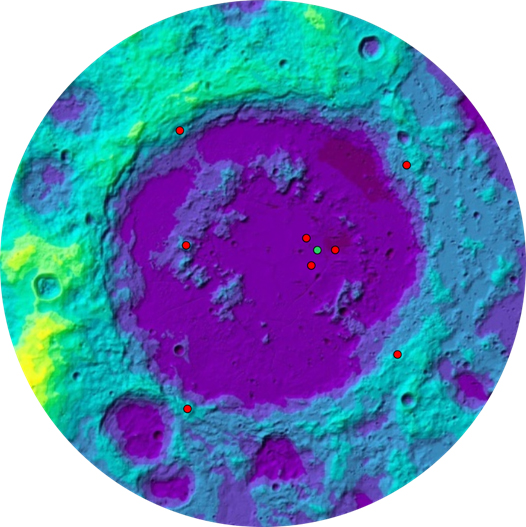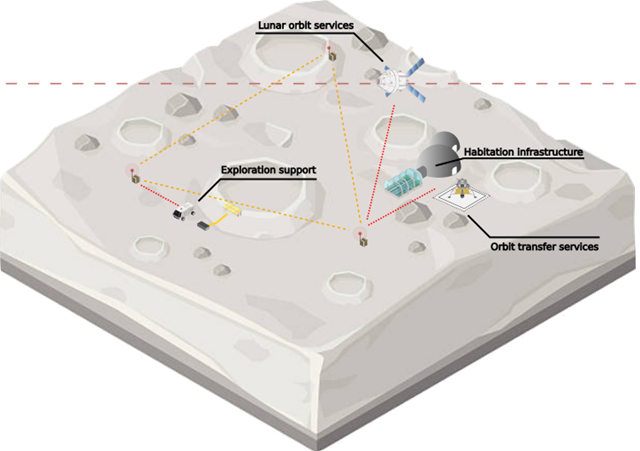- 1Finnish Meteorological Institute, Space Research and Observation Technologies, Helsinki, Finland (harri.haukka@fmi.fi)
- 2National Institute of Aerospace Technology, INTA, Spain
- 3Added Value Solutions, AVS, Spain
Introduction: LUNINA is an in-situ navigation and communication node. Proposed LUNINA platform is designed to be a compact, independent, cost effective, robust, and location independent navigation beacon and communication relay on the Moon that can operate 24/7.
The proposed concept is based on the ESA funded MiniPINS [1] project LINS platform capable of withstanding extended time periods on the lunar surface. The LINS was developed for the Schrödinger crater, but it can be deployed in any location on the Moon where there is at least some sunlight available. Each unit has been equipped with a RHU that keeps it warm and together with using solar panels and a battery is able to operate continuously.
The LUNINA node can be utilized in two main use cases, reliable navigation and communication on and around the moon. Each LUNINA unit provides the signal for navigation purposes. At an elevated location the unit helps with ground navigation for line-of-sight users as well as lunar orbit spacecraft. Accurate navigation is provided for applications such as spacecraft landing and launch from the lunar surface.
LUNINA node can work as a communication and data transfer relay for both ground and in-orbit users. At elevated location the node can cover a large surface area in line-of-sight and through a network of nodes relay messages. Around a base or other infrastructure, it can cover its vicinity and provide a communication link for the various applications.
Application: The LUNINA concept is a durable and relatively affordable navigation and communication node designed for lunar environment.
The MiniPINS developed the LINS capable of withstanding extended time periods on the lunar surface. An LTE system is used as a default communication and navigation payload for LUNINA platform.
The concept will work as a communication network and navigation aid for lunar missions, both on-ground and orbiting. The idea is to develop a 'drop and forget' long-term reliable element of a lunar infrastructure that will enable safe, reliable and flexible exploration of the lunar environment.
The LUNINA node can be deployed anywhere on the Moon where there is at least some sunlight present. The LINS platform was developed to operate on the Schrödinger crater (see Figure 1). Platform design has been equipped with a radioactive heating unit (RHU) that keeps the payload compartment warm and together with using solar panels and a battery the unit is able to operate continuously.

Figure 1: LUNINA nodes (in red dots) in Schrödinger crater around the Lunar Base (green dot).
The ESA MiniPINS LINS platform, as well as LUNINA, is designed to be deployed from a rover but can be modified to be deployable with other means such as from commercial lander missions.
The inclusion of an RHU would allow the thermalization of the in-situ LUNINA unit during the Lunar night, where energy storage need may lead to unaffordable battery volumes. Radioisotope power systems utilising americium-241 as a heat source fuel have been under development in Europe since 2009 as part of a European Space Agency funded programme led by the University of Leicester [2].
Use Case: The LUNINA node can be utilized in two main use cases - reliable navigation and communication on and around the Moon.
LUNINA can provide the signal with which different navigation methods can be used, such as ranging and range-rate. At an elevated location the node could help with ground navigation for line-of-sight users as well as lunar orbit spacecraft.
More accurate navigation could be provided for applications such as spacecraft landing and launch from the lunar surface with for example using the signal of more than one node around the surface launch site.
With respect to the communication, the node can work as a communication and data transfer relay for both ground and in-orbit users. At elevated location the node can cover a large surface area in line-of-sight and through a network of nodes relay messages. Around a base or other infrastructure, it can cover its vicinity and provide a reliable communication link for the various applications there, such as an ubiquitous safety and emergency link (see Figure 2).

Figure 2: Different applications of the LUNINA node.
Once the LCNS (Lunar Communications and Navigation Services) space segment is available the node is modular and can be updated to continue as a supporting infrastructure. The node signal can be used as one more source to provide an even more accurate navigation solution. Its drop locations can be chosen such that it helps with any location or temporal blind spots for the LCNS satellite signals (such as for example near crater edges).
Innovation: LUNINA is designed to be a compact, independent, cost effective, robust, and location independent navigation beacon and communication relay on the Moon that can operate 24/7 in any location. It's designed to be 'invisible' infrastructure. The platform is modular, the payload is easily updatable as long as the new payload meets the platform's requirements. The innovative features of the LUNINA node are:
- Compactness. The platform is based on the MiniPINS LINS
- Independency. The LINS his designed to operate 24/7 on Lunar environment. The same approach is used in the LUNINA platform.
- Cost-effectiveness. Using the heritage LINS, standardized parts and systems and existing payloads, the costs of development is minimized. Once node is developed, the node can be mass produced, bringing down its cost.
- Robustness and modularity. The node will use standardized interfaces and form factors both for its payload as well as its software will also be updateable.
- Durability. The node will have a long lifetime. All the node components will be designed and tested with durability in mind, the software will be upgradeable, and the node functionality and interfacing follow standards.
- Location-independency. The node will be a small and independent system deployable anywhere on the Moon.
References:
[1] Genzer M., et. al. "MiniPINS - Miniature Planetary In-situ Sensors", EGU21-11282, EGU General Assembly 2021 (2021), https://doi.org/10.5194/egusphere-egu21-11282. Contract is carried out and funded by the European Space Agency activity no. 1000025265 in the “ESA-Star” System.
[2] Ambrosi, et al., "European Radioisotope Thermoelectric Generators (RTGs) and Radioisotope Heater Units (RHUs) for Space Science and Exploration.", Space Sci Rev 215, 55 (2019), https://doi.org/10.1007/s11214-019-0623-9
How to cite: Haukka, H., Kestilä, A., Arruego, I., Harri, A.-M., Genzer, M., Apéstigue, V., Hieta, M., Camañes, C., Ortega, C., Kivekäs, J., and Koskimaa, P.: Lunar In-situ Navigation and Communication Node - LUNINA, Europlanet Science Congress 2024, Berlin, Germany, 8–13 Sep 2024, EPSC2024-43, https://doi.org/10.5194/epsc2024-43, 2024.